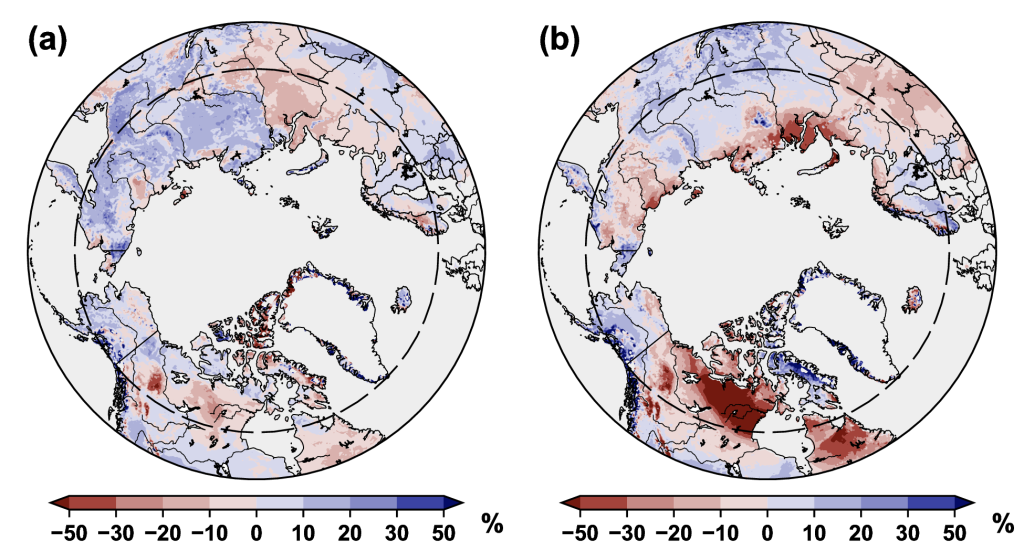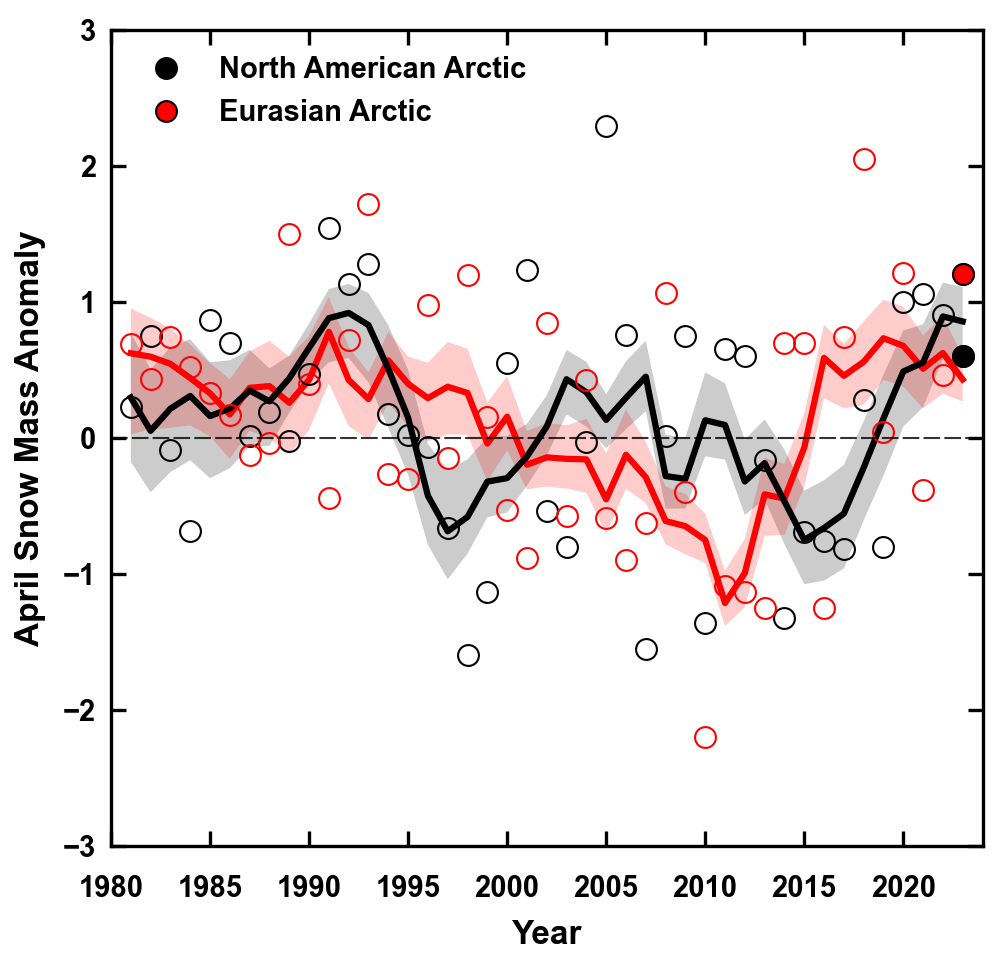L. R. Mudryk1, A. Elias Chereque2, C. Derksen1, K. Luojus3, and B. Decharme4
1Climate Research Division, Environment and Climate Change Canada, Toronto, ON, Canada
2Department of Physics, University of Toronto, Toronto, ON, Canada
3Arctic Research Centre, Finnish Meteorological Institute, Helsinki, Finland
4Centre National de Recherches Météorologiques, Météo-France, Toulouse, France
Headlines
- North American May snow cover extent set a record low in 2023 (lowest in the 57-year record) associated with high spring temperatures across the Northwest Territories and Nunavut.
- Snow accumulation during the 2022/23 winter was above average across both continents, particularly Eurasia.
- Since 2010, there was a near-complete absence of snow cover in June in Eurasia (except for residual amounts at higher elevations) for 11 of the 14 years; this lack of June snow cover did not occur at all between 1967 and 2009.
Introduction
Many Arctic land surface processes are directly influenced by snow cover from fall through spring, including the surface energy budget, ground thermal regime, permafrost, and terrestrial and freshwater ecosystems (Brown et al. 2017; Meredith et al. 2019). Even following the snow cover season, the influence of spring snow melt timing persists through impacts on river discharge timing and magnitude, surface water, soil moisture, vegetation phenology, and fire risk (Meredith et al. 2019).
Multiple datasets derived from satellite observations and snowpack models driven by atmospheric reanalyses are used to assess Arctic seasonal snow cover. Collectively, this approach provides a reliable picture of Arctic snow cover variability over the last five decades. We characterize snow conditions across the Arctic land surface using three quantities: how much total land area is covered by snow (snow cover extent – SCE), how much of the year snow covers the land surface (snow cover duration – SCD), and how much total water is stored in solid form by the snowpack (snow water equivalent – SWE; the product of snow depth and density). We examine each of these quantities in turn for the 2022/23 Arctic snow season.
Snow cover extent and duration
SCE anomalies (relative to the 1991-2020 baseline) in spring 2023 are shown separately for the North American and Eurasian sectors of the Arctic in Fig. 1. North American May SCE set a record low in 2023 (lowest SCE in the 57-year record) associated with spring temperatures up to 5°C above normal across the region (see essay Surface Air Temperature) but rebounded slightly by June (ranked 4th lowest). In the Eurasian sector, May anomalies were close to the 1991-2020 average but were well below normal by June (ranked 9th lowest in the 57-year record).

SCD anomalies (Fig. 2a) during the 2022/23 snow season had a combination of early and late snow onset (relative to a 1998/99 to 2017/18 baseline) with an especially variable pattern across the North American Arctic. Across central and eastern Eurasia Arctic snow onset occurred earlier than normal while across western Eurasia there was a modest delay. The signal of extensive snow melt across North America in May SCE is also apparent in the signal of spring SCD anomalies (Fig. 2b) where a broad swath of mainland Nunavut and Northwest Territories in Canada saw a more than 50% increase in the number of snow-free days in spring. While spring snow melt across Eurasia was not as extensive as in the previous two years, far northern coastal regions across the continent still had above-normal numbers of snow-free days indicative of earlier snow melt.


Snow mass and snow water equivalent
Snow mass across the Arctic tends to peak annually during April, when snowfall has accumulated since the preceding autumn but before increasing temperatures during May and June lead to snow melt. Snow mass anomalies for April 2023 (Fig. 3; calculated by aggregating SWE across the Arctic land surface to measure the total mass of water stored by snow across the region) indicate snow accumulation was above the 1991-2020 baseline across both continents (consistent with the wet autumn and winter reported in the Precipitation essay), but especially Eurasia where it was the fifth highest accumulation in the record. The spatial patterns of monthly mean SWE (Fig. 4) illustrate how this accumulation varied regionally from just before peak (March) through to the end of the melt period (June). Regions with positive SWE anomalies in March had even stronger positive anomalies by May (most of Alaska, large parts of central and eastern Siberia), which suggests that snow in these regions took longer to melt compared to the historical baseline. Mainland Arctic Canada was an exception. This region experienced extensive reductions in SWE during May which extended northward into the southern Canadian Arctic Archipelago during June. By June snow was mostly melted across both continents except for Baffin and the Queen Elizabeth Islands in the Canadian Arctic Archipelago. Early snow melt across mainland Arctic Canada (and boreal regions to the south) during spring 2023 and summer precipitation deficits (see essay Precipitation) may both have contributed to the extensive summer 2023 wildfire season, which forced the complete evacuation of communities in the western Canadian Arctic (see Arctic Wildfire Sidebar).




Summary and long-term trends
Snow accumulation during the 2022/23 winter was above average across both continents, especially Eurasia. This allowed above normal SWE in some regions to persist into May (e.g., central Siberia and Alaska). However, intensive melt during spring across Arctic Canada resulted in a new record low May snow extent for the North American Arctic. Looking historically across Eurasia, the June snow extent values for 11 of the past 14 years represent near complete absence of snow cover across the continent except for residual amounts in higher elevation locations. Compared to historical conditions, this results in approximately two additional weeks of snow-free conditions before July. The more northernly location of the Canadian Arctic Archipelago prevents complete loss of snow extent until after June across the North American sector of the Arctic.
Methods and data
SCE anomalies are derived from the NOAA snow chart climate data record, which extends from 1967 to present (Estilow et al. 2015; Robinson et al. 2012). Monthly anomalies of total areal snow cover over land for a given Arctic sector (North America or Eurasia, > 60° N) are computed and standardized relative to the 1991-2020 period (each observation differenced from the mean and divided by the standard deviation and thus unitless).
SCD fields are derived from the NOAA daily Interactive Multisensor Snow and Ice Mapping System (IMS) snow cover product (U.S. National Ice Center 2008). Anomalies in the total number of days with snow cover were computed separately for each half of the snow season: August 2022 to January 2023, referred to as “onset period,” and February 2023 to July 2023, referred to as “melt period.” IMS availability starts in 1998, so a 1998/99 to 2017/18 climatological period is used (including information from August-December 1998 for snow onset). Anomalies for each season are presented as percent differences from the climatological number of snow-free days. In the Arctic, this varies from approximately three months near 60° N, to approximately two months at 70° N, and decreases to less than a month over the Canadian Arctic Archipelago. Because the Arctic is generally always snow covered between November and April, Arctic region snow onset anomalies are indicative of conditions during September and October, while Arctic region snow melt anomalies are indicative of conditions during May and June.
Four SWE data sets were used to generate multi-dataset SWE fields from March-June (inclusive) for the 1981-2023 period: (1) the European Space Agency Snow Climate Change Initiative (CCI) SWE version 2 product derived through a combination of satellite passive microwave brightness temperatures and climate station snow depth observations (Luojus et al. 2022); (2) the Modern-Era Retrospective Analysis for Research and Applications version 2 (MERRA-2, GMAO 2015; Gelaro et al. 2017) daily SWE fields; (3) SWE output from the ERA5-Land analysis (Muñoz Sabater 2019); and (4) the physical snowpack model Crocus (Brun et al. 2013) driven by ERA5 meteorological forcing. Limited availability of climate station snow data during May and June lowers the accuracy of the Snow CCI SWE product during these months; therefore, we only use it during March and April. An approach using gridded products is required because in situ observations alone are too sparse to capture snow conditions across the Arctic. We consider multiple datasets because averaging multiple SWE products has been shown to be more accurate than individual datasets when validated with in situ observations (Mortimer et al. 2020). The ensemble-mean SWE field is used to calculate monthly SWE anomalies relative to the 1991-2020 period, which are presented as percent differences. For April, the SWE fields for each product are also aggregated across Arctic land regions (> 60° N) for both North American and Eurasian sectors to produce multiple estimates of April snow mass. These monthly snow mass values are used to calculate standardized anomalies relative to the 1991-2020 period for each data product. The standardized anomalies are then averaged to produce an ensemble-mean time series.
Acknowledgments
ERA5-Land data (Muñoz Sabater 2019) was downloaded from the Copernicus Climate Change Service (C3S) Climate Data Store (2023). Neither the European Commission nor ECMWF is responsible for any use that may be made of the Copernicus information or data it contains.
References
Brown, R., and Coauthors, 2017: Arctic terrestrial snow cover. In: Snow, Water, Ice and Permafrost in the Arctic (SWIPA) 2017. pp. 25-64, Arctic Monitoring and Assessment Programme (AMAP), Oslo, Norway.
Brun, E., V. Vionnet, A. Boone, B. Decharme, Y. Peings, R. Valette, F. Karbou, and S. Morin, 2013: Simulation of Northern Eurasian local snow depth, mass, and density using a detailed snowpack model and meteorological reanalyses. J. Hydrometeor., 14, 203-219, https://doi.org/10.1175/JHM-D-12-012.1.
Estilow, T. W., A. H. Young, and D. A. Robinson, 2015: A long-term Northern Hemisphere snow cover extent data record for climate studies and monitoring. Earth Syst. Sci. Data, 7, 137-142, https://doi.org/10.5194/essd-7-137-2015.
Gelaro, R., and Coauthors, 2017: The Modern-era retrospective analysis for research and applications, Version 2 (MERRA-2). J. Climate, 30, 5419-5454, https://doi.org/10.1175/JCLI-D-16-0758.1.
GMAO (Global Modeling and Assimilation Office), 2015: MERRA-2tavg1_2d_lnd_Nx:2d, 1-Hourly, Time-Averaged, Single-Level, Assimilation, Land Surface Diagnostics V5.12.4, Goddard Earth Sciences Data and Information Services Center (GESDISC), accessed: 3 August 2023, https://doi.org/10.5067/RKPHT8KC1Y1T.
Luojus, K., and Coauthors, 2022: ESA Snow Climate Change Initiative (Snow_cci): Snow Water Equivalent (SWE) level 3C daily global climate research data package (CRDP) (1979 – 2020), version 2.0. NERC EDS Centre for Environmental Data Analysis, accessed: 27 August 2023, https://doi.org/10.5285/4647cc9ad3c044439d6c643208d3c494.
Meredith, M., and Coauthors, 2019: Polar Regions. IPCC Special Report on the Ocean and Cryosphere in a Changing Climate, H. -O. Pörtner, and co-editors, Cambridge University Press, Cambridge, UK and New York, NY, USA, 203-320, https://doi.org/10.1017/9781009157964.005.
Mortimer, C., L. Mudryk, C. Derksen, K. Luojus, R. Brown, R. Kelly, and M. Tedesco, 2020: Evaluation of long-term Northern Hemisphere snow water equivalent products. Cryosphere, 14, 1579-1594, https://doi.org/10.5194/tc-14-1579-2020.
Muñoz Sabater, J., 2019: ERA5-Land hourly data from 1950 to present. Copernicus Climate Change Service (C3S) Climate Data Store (CDS), accessed: 3 October 2023, https://doi.org/10.24381/cds.e2161bac.
Robinson, D. A., T. W. Estilow, and NOAA CDR Program, 2012: NOAA Climate Data Record (CDR) of Northern Hemisphere (NH) Snow Cover Extent (SCE), Version 1 [r01]. NOAA National Centers for Environmental Information, accessed: 30 August 2023, https://doi.org/10.7289/V5N014G9.
U.S. National Ice Center, 2008: IMS Daily Northern Hemisphere Snow and Ice Analysis at 1 km, 4 km, and 24 km Resolutions, Version 1. Boulder, Colorado, USA. NSIDC: National Snow and Ice Data Center, accessed: 18 August 2023, https://doi.org/10.7265/N52R3PMC.
November 27, 2023
